1. Introduction
A crucial aspect of DAB (Digital Audio Broadcasting) applications is the Announcement functionality. How to test Announcements becomes a significant topic in the test and measurement field. Whether to seek ETI test streams for functional verification or to configure underlying parameters for functional testing is a question that any engineer involved in this task must face.
Generally, for DAB testing, the two most critical standard documents we refer to are:
ETSI EN 300 401 V2.1.1 (2017-01):
Radio Broadcasting Systems; Digital Audio Broadcasting (DAB) to mobile, portable and fixed receivers
ETSI TS 103 176 V2.2.1 (2018-10):
Digital Audio Broadcasting (DAB); Rules of implementation; Service information features
The DAB Announcement function discussed in this document is detailed primarily in the second document. Interested readers are encouraged to consult it.
2. DAB Announcement Overview
In simple terms, a DAB Announcement can be understood as an information voice broadcast. It can be categorized into various types, including: Warning (Alarm), Traffic, News, Sports, or Other. To implement this function, a signaling method must be defined, enabling receivers to possess this capability. Receivers must be able to receive the information upon request, broadcast it, and then return to the audio broadcast afterward.
It is important to note that announcement types are divided into two priority levels: the high-priority level is Warning (Alarm), while others are low-priority. The standard provides specific provisions for Alarm announcements. Once the broadcast type is identified as Alarm, all receivers must process it with the highest priority.
The announcement content can originate from the current ensemble's multiplexer or from other multiplexers. If it comes from the current multiplexer, the receiver does not need to re-tune the frequency or parse to find the channel containing the broadcast content. However, if the announcement content comes from another multiplexer, the receiver must re-tune to that other channel to receive it. This mode is relatively complex and requires attention from receiver developers.
Regardless of the type of announcement broadcast, once completed, the receiver must automatically return to the original program to continue broadcasting.
3. DAB Announcement Test Solutions
3.1 Based on ETI Test Streams
One of the most straightforward methods to test DAB Announcement is to find a compliant ETI (Ensemble Transport Interface) stream, modulate it, and provide it to the receiver for verification. This method is simple in principle but challenging in practice. Theoretically, any change in parameters results in a different ETI stream. Therefore, finding various ETI streams that meet all requirements is not a simple task. This is one reason why many manufacturers experience low efficiency in DAB Announcement testing.
If a compliant ETI test stream is available, modulation is straightforward. Selecting a signal generator supporting the DAB standard suffices. Many devices in the industry support this, such as the RWC2010C, which can directly play ETI streams, modulate and output DAB signals, and flexibly change frequency and power.
3.2 Based on IQ Captured Data Streams
This method typically involves using an RF recorder/replayer. It directly records the actual DAB Announcement signal as IQ data, which is then brought back to the laboratory for signal replay and re-modulation into an RF signal.
Generally, achieving high-precision RF recording requires a high A/D quantization depth and a high sampling rate, leading to very high data rates. Consequently, higher-performance RF recorders tend to be relatively expensive, while more economical RF recorders may not meet the requirements for precision testing.
Similar to the ETI stream approach, a challenge with this method is also the need to find specific scenarios. Each scenario usually only satisfies one mode. Therefore, achieving comprehensive testing requires finding a wide variety of scenarios, which is quite difficult.
3.3 Based on Professional RF Test Instruments
Using a professional DAB test instrument equipped with an efficient DAB Announcement testing function offers significant convenience. A typical test diagram is shown in Figure 1.

Figure 1: Test Diagram
Generally, a professional DAB Announcement test tool needs to support CLUSTER setting, AN Switching setting, AN switch type, and Target Channel setting, as shown in Figure 2.
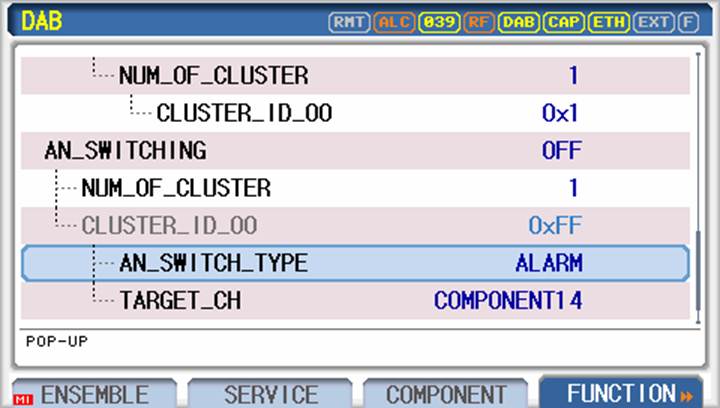
Figure 2: Announcement General Settings
Simultaneously, the device must also support switching between multiple Switch types, as shown in Figure 3.

Figure 3: Switch Type Selection
Based on the above configurable instrument interface, we can design highly flexible Announcement application scenarios, simulating any standard-compliant Announcement test.
Here is a typical configuration example: CLUSTER 1 switching to Weather type Announcement.
The instrument's initial service configuration is as follows:
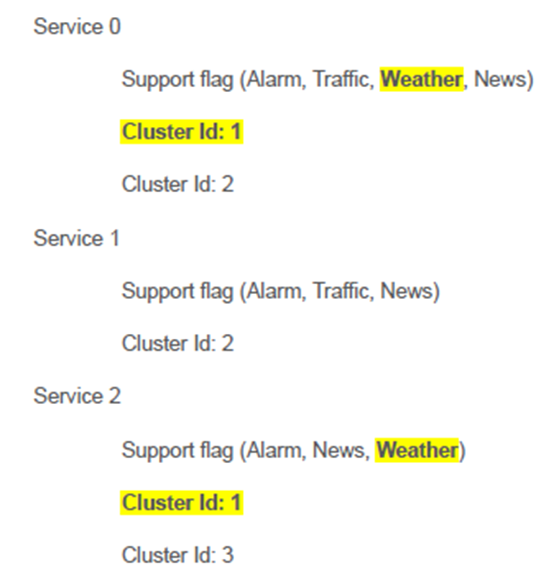
If the Announcement switching is set as follows:
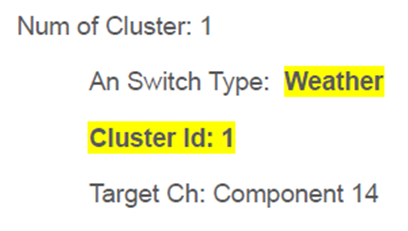
The initial operating mode of the entire system and the mode after enabling the Announcement can be intuitively displayed in Figure 4.
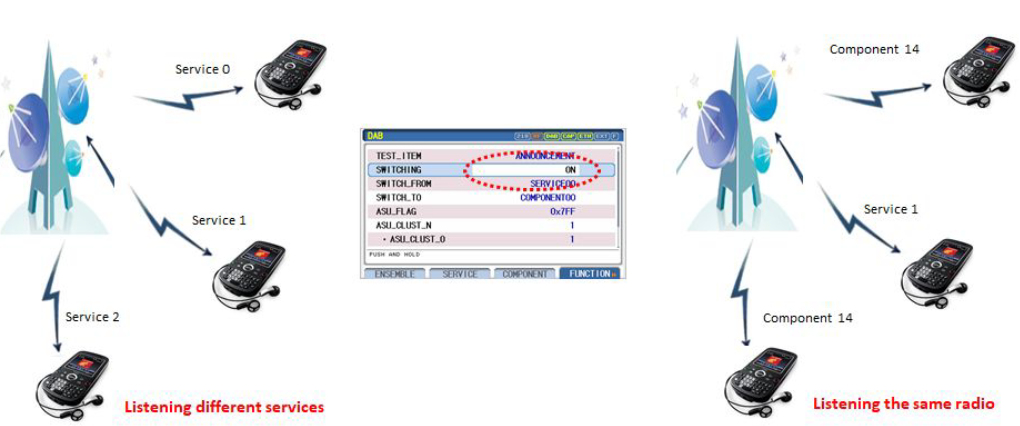
Figure 4: Workflow Diagram
Interpretation: When the test signal generator operates in its initial state, the devices under test are each in their own reception state – three receivers are tuned to Service 0, Service 1, and Service 2 programs, respectively. After enabling the Announcement, the receiver operating within CLUSTER ID 1 will automatically switch to the WEATHER type and play the content according to the Target Channel 14.
4. Test Solution Comparison
A simple comparison of the three test solutions can be summarized as follows:

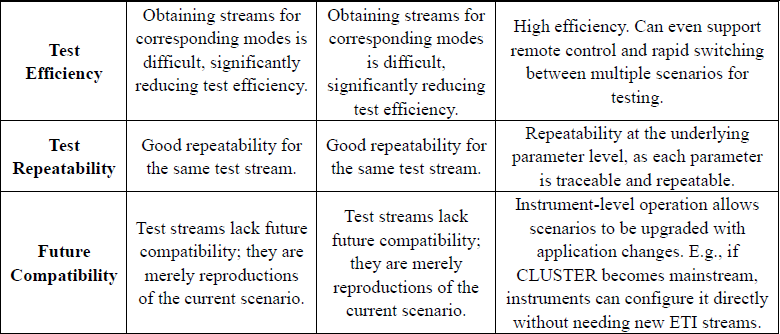
5. Introduction to Typical Test Instruments
For DAB Announcement testing, the RWC2010C equipment operated and sold by Doewe Technologies fully meets the requirements.
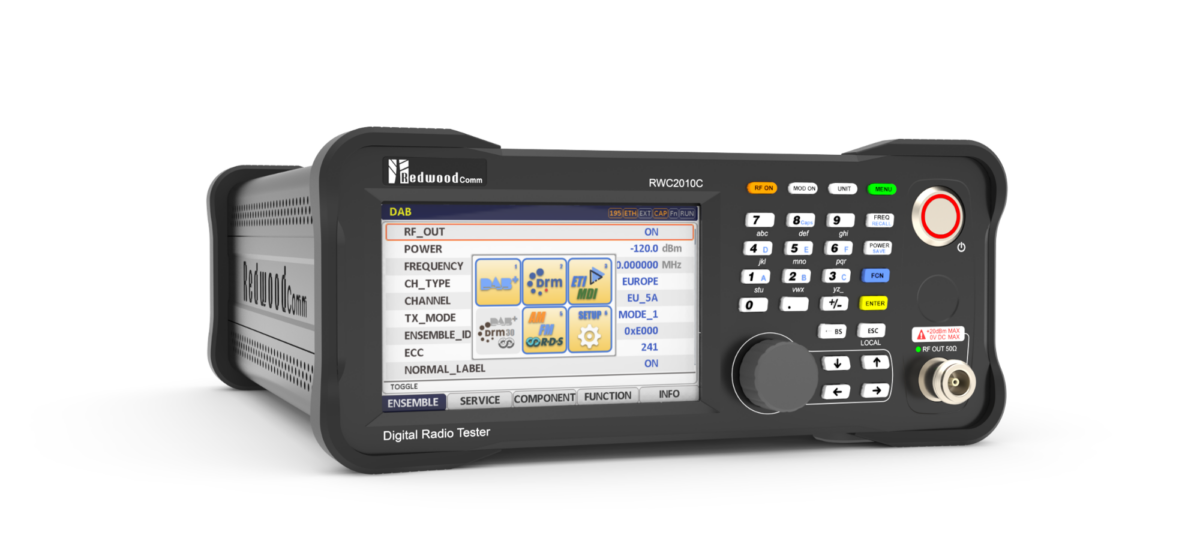
This device supports AM and FM analog modulation, as well as DAB/DRM digital modulation, and can output multiple FM signals simultaneously. Particularly noteworthy is its support for flexible baseband multiplexing, an industry-unique feature allowing stream-level multiplex configuration for DAB and DRM, greatly enhancing test flexibility and efficiency. The device supports comprehensive DAB additional function testing, such as Seamless Linking (which may require other devices/software depending on the test needs) and DAB Announcement.
It should be noted that this device also satisfies the ETI stream-based testing approach. Readers are advised to refer to the RWC2010C product brochure and related materials, or contact our company by phone for consultation.
If readers need to test based on IQ captured data streams, they can consider using the MP7600 provided by Doewe Technologies. This device supports 16-bit depth and high-speed sampling, enabling near-distortionless RF signal reproduction. It is especially useful for simultaneously recording wideband signals leveraging its maximum real-time bandwidth of 100 MHz.
6. Conclusion
The ultimate goal of any communication standard is to provide services to users. DAB Announcement is precisely such a service, albeit one built upon the broader DAB framework. However, for any service to be stable and reliable, comprehensive testing across three dimensions is essential: the physical layer, the signaling protocol layer, and the application layer. Utilizing the RWC2010C equipment provided by Doewe Technologies allows for highly efficient DAB Announcement testing. It enables the construction of various simple or complex, standard-compliant test scenarios and facilitates repeatable testing. This can significantly improve R&D, production, and quality inspection efficiency for radio manufacturers or car radio manufacturers. For relevant research or production units that wish to utilize RF equipment for testing while also performing real-world verification, the ETI stream and IQ data stream-based methods can serve as complementary approaches, each enhancing the other.